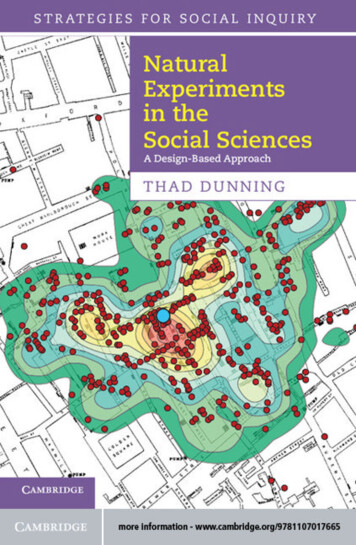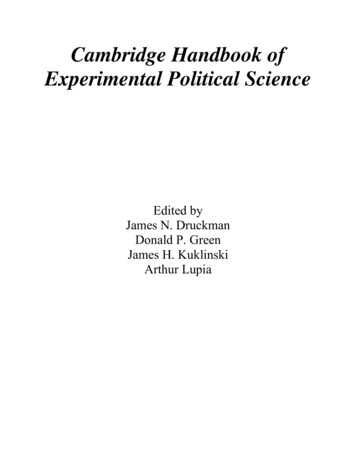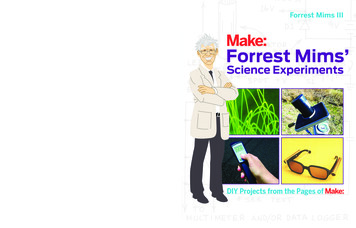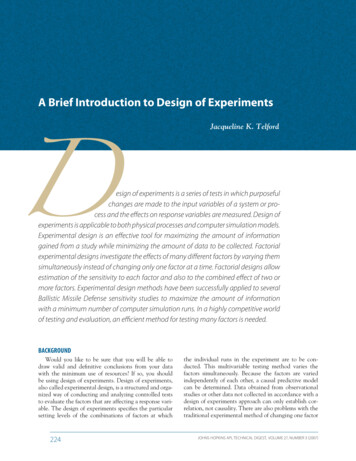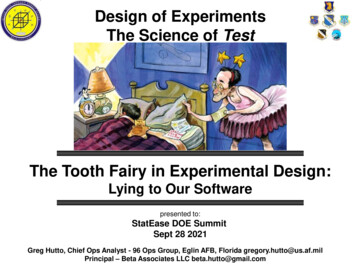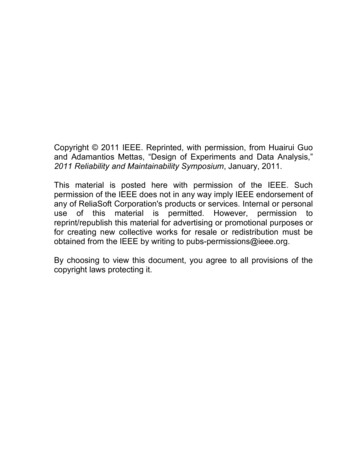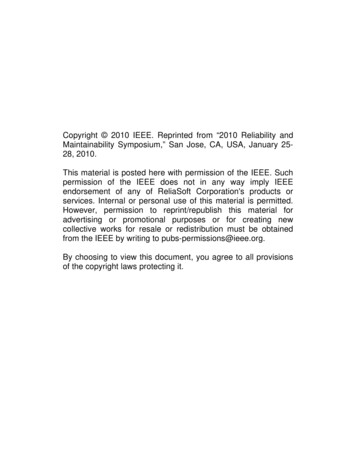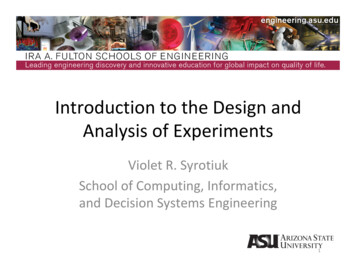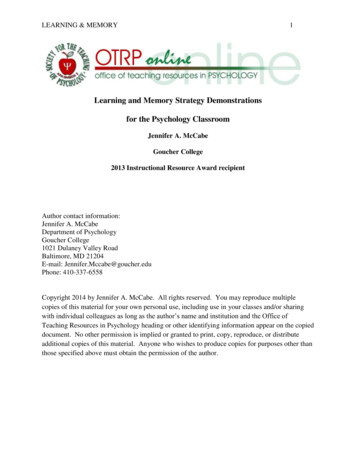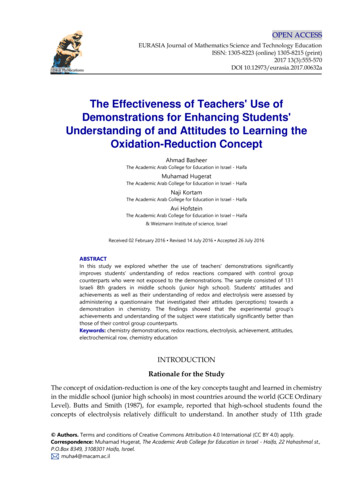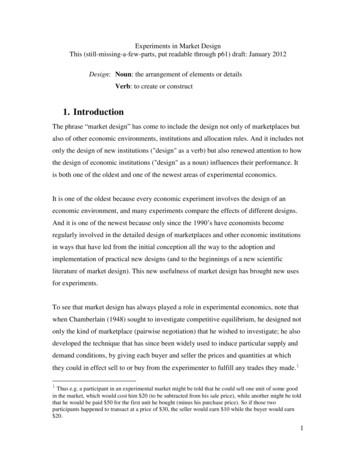
Transcription
SCIENCE DEMONSTRATIONS, EXPERIMENTS,AND RESOURCESA reference list for elementary through college teachersemphasizing chemistry with some physics and life scienceOriginally published in the Journal of Chemical Education, Vol. 68, Page 235, March 1991 and updated 2005compiled byDavid A. KatzChemist, Educator, Science Communicator, and Consultant133 N. Desert Stream Dr., Tucson, AZ 85745-2207, USAVoice/Fax/Message: 520-624-2207 Email: dakatz45@msn.comAuthor’s note: This is a work in progress. Updating will be continuing on this reference list through thefuture on an irregular schedule. Since the original publication of this article, many of these books havegone out of print and a number of publishers have gone out of business or have been bought out by otherpublishing houses. The publishers and list of publishers has not been updated from the 1991 article,however, it is easy to check current address or status of publishers through the Internet.Some science supply companies, such as S17 Science and Supplies (S17science.com) and Flinn ScientificCo., stock some of these books, including a few titles that are out-of-print. Contact them directly for copiesof their catalogs. Search for out-of-print books using the Internet and a search engine such as Google.Another source of out-of-print books is Amazon.com, they do not stock out-of-print books, but will do abook search if you request a copy.1. JOURNALSJournals will usually require membership in or affiliation with a professional organization. Many libraries,especiallycollege libraries in schools which offer degrees in education, will often have these journals available. Addresses ofprofessional organizations and journal and book publishers are listed at the end of this compilation.Science and Children, National Science Teachers Association.Designed for elementary and middle school science teaching. Contains activities, projects, program reports,reviews, hints, sky charts, background articles, and more.Science Scope, National Science Teachers Association.Designed for middle/junior high school science teachers. Particularly strong in activity-oriented articles alongwith information articles and news items.The Science Teacher, National Science Teachers Association.Designed for junior and senior high school science teachers. Contains demonstrations, experiments, sourcesof free or inexpensive teaching materials, reviews, posters, and other teaching ideas.The Journal of College Science Teaching, National Science Teachers Association.Designed for college science teachers. Main focus is on educational issues, and innovative techniques withsome experiments and demonstrations.
The Journal of Chemical Education, Division of Chemical Education, American Chemical Society.Designed for high school and college chemistry teachers. Covers all areas of chemistry through principles,innovative techniques, experiments, and demonstrations. Of particular note is the “Tested Demonstration”Column. (Indices are available in booklet form or on diskette.)ChemMatters, Office of High School Chemistry, American Chemical Society.Designed for high school students. Contains activities and articles focusing on chemistry of everyday things.All back issues are available on CD-ROM from the American Chemical Society Office of Education.Chemunity, Office of High School Chemistry, American Chemical Society.Designed for high school teachers. Contains articles of interest along with news of workshops and specialprograms for teachers.WonderScience, Office of Pre-High School Chemistry, American Chemical Society.This excellent magazine is no longer in print. It was aimed at elementary and middle school students.Activities youngsters can do at home with the assistance of an adult. Utilizes household materials. Wellillustrated. Back copies are compiled in two books titled The Best of WonderScience, available from TheAmerican Chemical Society Office of Education.The Physics Teacher, American Association of Physics Teachers.Designed for high school and college physics teachers.experiments, and demonstrations.Articles on principles, innovative techniques,Chem 13 News, Department of Chemistry, University of Waterloo.For high school chemistry teachers. General articles, experiments, demonstrations, humor, and reviews ofbooks and apparatus.Scientific American, Scientific American, Inc.The Amateur Scientist column by C. L. Strong, Jearl Walker and others, usually contains advanced projectssuitable for high school or above. Worth browsing through in the library as it may often contain someinteresting information suitable for pre-high school classes. All the Amateur Scientist columns are availableon CD-ROM.Chemistry, American Chemical Society (out of print)This should be available in a library. Of particular interest is the “Lab Bench” column. (Available in reprintas “Lab Bench Experiments in Chemistry”.)2. BOOKSSource books for experiments, activities, demonstrations, and information. Many books duplicate activities found inothers with variations in set-up and applications. Activities can be modified to be applicable to any level and materialsand apparatus can often be simplified. Addresses of publishers are listed at the end of this compilation.Alexander, Allison, and Bower, Susie, Science Magic; Prentice-Hall, 1986.19 experiments, using common materials, designed for youngsters 4 to 8 years old with parental guidance.Topics include heat, light, mirrors, water works, and sound. Each experiment is well illustrated with briefexplanations of the science behind it.Allison, Linda, and Katz, David, Gee, Wiz! How to Mix Art and Science or The Art of Thinking Scientifically; TheYolla Bolly Press, 1983.Written for children and adults. Contains experiments in science that use everyday materials along with clearand simple explanations. This is an excellent source of projects.2
Alyea and Dutton, Tested Demonstrations in Chemistry, 7th Ed; Journal of Chemical Education.This is the “Bible” for Chemical Demonstrations. Some are suitable for elementary school, but most are formiddle school or above. You should have some knowledge of chemistry. Mostly outlines of demonstrations,including how to make up solutions, with little or no explanation, but well referenced to the Journal ofChemical Education. Has little safety information other than occasional “Caution” statements. A number ofdemonstrations are dangerous and care should be exercised in selection. (Note: This book has been updated byGeorge Gilbert, with better explanations and safety information. See the entry under George’s name.)Alyea, Hubert, TOPS in General Chemistry, 3rd Ed.; Journal of Chemical Education.Experiments for projecting with an overhead projector. Use with Alyea’s inclined plane, build a specialadapter, or use petri dishes instead of Alyea’s cells.Alyea, Hubert, Micro-Chemistry Projected, 2nd Ed; Tops.Companion to TOPS book. More micro experiments to project for your classes.Alyea, Hubert, Armchair Chemistry, 2nd Ed; Tops.How to put a chemistry lab in the hands of each student. Once set up, this can provide many studentexperiments at low cost. (This is the original “microscale” chemistry book. Alyea was decades ahead ofeveryone in bringing hands-on chemistry into the classroom.)Amery, Heather, The Know How Book of Experiments; Usborne, 1977.A well illustrated collection of safe and simple physical science experiments for youngsters to do at home.Utilizes lots of common materials. Tells why each experiment works and includes interesting facts and applications.Amery, Heather, and Littler, Angela, The Know How Book of Batteries and Magnets; Usborne, 1975.A well illustrated collection of safe and simple electrical (battery powered) activities making games and modelsfor youngsters, ages 7 to 12. Utilizes common materials, but does require a trip to an electronics or hardwarestore.Barr, George, Science Projects for Young People; Dover, 1986.A reprint of the 1964 edition. Projects intended for elementary school children using household materials.Topics include light and color, electricity and magnetism, water and earth science, air and weather, sound,chemistry, plants, animals, and science in the home.Barr, George, Science Tricks and Magic for Young People; Dover, 1987.A reprint of the 1968 edition. Twenty-four scientific tricks, using common materials, involving air pressure,electricity, liquids, light, heat, motion, and more.Becker, Bob, 20 Demonstrations Guaranteed to Knock Your Socks Off!, Flinn Scientific 1993.Available with an accompanying video, Bob Becker shows how to prepare and perform 20 excitingdemonstrations.Becker, Bob, 20 Demonstrations Guaranteed to Knock Your Socks Off! Volume II, Flinn Scientific 1993.Available with an accompanying video, Bob Becker shows how to prepare and perform an additional 20exciting demonstrations.Berry, Donna A., A Potpourri of Physics Teaching Ideas; AAPT, 1987.Selected reprints from The Physics Teacher, April 1963-December 1986. Articles include explanations ofphenomena and everyday things, construction projects, demonstrations, and class activities requiring apparatusranging from simple to complex. Appears best suited for middle school thru college, but many ideas usefulfor elementary teachers.Bohren, Craig F., Clouds in a Glass of Beer; Wiley, 1987.Explanations of atmospheric physics with over 25 experiments to observe or reproduce natural phenomena.3
Borgford, Christie L., and Summerlin, Lee R., Chemical Activities; ACS, 1988.Laboratory activities in many areas of chemistry for junior high and high school students. Each experimentincludes step-by-step directions and some questions. For explanations, obtain the Teacher Edition.Brin, Susannah, and Sundquist, Nancy, 50 Science Experiments I Can Do; Price Stern Sloan, 1988.50 experiments for children with air, bubbles, color,chemistry, insects, light, plants, rocks and minerals,weather, and more using common materials. Most experiments are simple, but a few should have adultsupervision.Brown, Bob, More Science for You - 112 Illustrated Experiments; Tab, 1988.Experiments with vision, motion, weight, surface tension, temperature, sound, light, magic, and other topics.Each experiment briefly lists the problem, materials needed, what to do, and an answer or explanation with anillustration, all on one page. Adult supervision recommended.Brown, Robert J., 333 Science Tricks and Experiments; Tab, 1984.A collection of science tricks and experiments in many areas taken from the author’s syndicated column“Science For You”Brown, Robert J., 333 More Science Tricks and Experiments; Tab, 1984.More tricks and experiments from Brown’s “Science For You” column.Brown, Robert J., 200 Illustrated Science Experiments for Children; Tab, 1987.Experiments and projects with air, sound, water, surface tension, mechanics, chemistry, light, heat, biology,electricity and magnetism, and more. Recommended for children with adult supervision.Brown, Sam Ed, Bubbles, Rainbows, and Worms; Gryphon House, 1981.A well organized book of science experiments for pre-school children using air, animals, the environment,plants, senses, water, and more. Each section contains a listing of relevant books for children.Caney, Steven, Steven Caney’s Invention Book; Workman, 1985.Describes many inventions such as Life Savers, Chocolate Chip Cookies, Levi’s, and more. Some projects areincluded. Great source book for class discussions.Caney, Steven, Steven Caney’s Play Book; Workman, 1975.Contains over 70 games and projects using inexpensive materials. Make balloon rockets, boomerangs, solarheaters, sun clocks, roll back cans, salt gardens, and more. Hazard Alert: Directions for The Wave Machinecall for alcohol and paint thinner. This is a fire/explosion hazard. Substitute mineral oil and water.Caney, Steven, Steven Caney’s Toy Book; Workman, 1972.Describes how to make toys using everyday materials. This includes many science toys such as a water lens,barometer, tube telephone, a movie wheel and more.Carson, Mary Stetten, The Scientific Kid; Harper & Row, 1989.Thirty-five experiments for elementary school youngsters, some requiring adult assistance, covering a widerange of activities in the physical and biological sciences. Each activity contains step by step illustrateddirections and is accompanied by a photograph.Catherall, Ed, Adhesion; Wayland, 1983.Investigations into viscous liquids, adhesion, and adhesives in nature for youngsters using common materials.Twenty-nine illustrated experiments ask lots of questions to be answered by observations and offer a few briefexplanations when needed.4
Catherall, Ed, Elasticity; Wayland, 1983.Investigations into stretching materials, elastic materials, and springs, for youngsters using common materials.Twenty-nine illustrated experiments ask lots of questions to be answered by observations and offer a few briefexplanations when needed.Catherall, Ed, Friction; Wayland, 1983.Investigations into slopes, friction, and reducing friction for youngsters using common materials occasionallyrequiring some construction of apparatus. Twenty-nine illustrated experiments ask lots of questions to beanswered by observations and offer a few brief explanations when needed.Chen, Philip S., Entertaining and Educational Chemical Demonstrations; Chemical Elements, 1974.Knowledge of chemistry is needed. Some pyrotechnics demonstrations included without adequate safetyinformation.Chisholm, Jane and Johnson, Mary, Introduction to Chemistry; Usborne, 1983.An illustrated introduction to chemistry for youngsters. It explains concepts of atoms and molecules, valency,chemical reactions, along with some chemistry of everyday things. Some experiments, but only generaldirections.Cobb, Vicki, and Darling, Kathy, Bet You Can!; Avon, 1983.A collection of science tricks you can do with simple explanations. Covers chemistry, physics and math.Cobb, Vicki, and Darling, Kathy, Bet You Can’t!; Avon, 1980.A collection of science tricks you can’t do. Covers chemistry, physics and math.Cobb, Vicki, Chemically Active; Lippincott, New York, 1985A collection of chemical experiments using materials found at home combined with explanations of chemicalprinciples.Cobb, Vicki, Fuzz Does It; Lippincott, 1982.Easy to do experiments with animal fuzz, plant fuzz, fuzz from webs and cocoons, fibers, and more. Containsa simple fiber identification chart.Cobb, Vicki, Gobs of Goo; Lippincott, 1983.Easy to do experiments with goo using household materials. Includes mayonnaise, flour and water, starch andwater, egg whites, and other gooey things.Cobb, Vicki, The Secret Life of Hardware; Lippincott, 1982.Science experiments with cleaners, polishes, waxes, paints, rope, glue, tools, and electricity. Each sectionexplains how things were invented and why things work.Cook, James G., and The Thomas Alva Edison Foundation, The Thomas Edison Book of Easy and IncredibleExperiments; Wiley, 1988.A wide range of experiments for youngsters ranging from elementary through high school. Experiments coverchemistry, electrochemistry, electricity, magnetism, solar energy, nuclear science, and more. Items to buildinclude a phonograph, a pinhole camera, an electric pencil, a radio, a Geiger counter, and more. Also containsa bibliography of books for information and additional experiments.Disney, Walt, Simple Science; Bantam, 1986.Using a storybook format, a walk with Snow White introduces scientific principles about the weather, seasons,insects, birds, plants and trees. A second story uses Mickey Mouse to introduce principles and activity ideason sound, taste, magnets, and plants. Applicable to pre-school up to about 2nd grade.5
Edge, R. D., String & Sticky Tape Experiments; AAPT, 1987.Over 150 experiments in physics utilizing rubber bands, cellulose tape, paper clips, drinking straws, and othercommon materials. Experiments cover all fields of physics and are indexed as to applicable level (elementarythru university), degree of difficulty, and qualitative vs quantitative.Ehrlich, Robert, Turning the World Inside Out; Princeton, 1990.A collection of physics demonstrations covering motion, gravity, friction, fluids, heat, waves, electricity, magnetism, and more. Contains an index of those with surprising results, relative cost factors, need for overhead projector, need construction, and relative time.Forte, Imogene, Science Fun; Incentive, 1985.Divided into three sections, investigating, exploring, and experimenting, this book attempts to help youngstersappreciate the science in everyday life. Some experiments should have adult supervision.Freier, G. D. and Anderson, F. J., A Demonstration Handbook for Physics, 2nd Edition; AAPT, 1981.A handbook of physics demonstrations for high school and college teachers. Each demonstration is brieflydescribed and illustrated.Gardner, Martin, Entertaining Science Experiments with Everyday Objects; Dover, 1981.Experiments in chemistry, physics, psychology, physiology, astronomy and math.Gardner, Robert, Kitchen Chemistry; Messner, 1988.Chemistry experiments with liquids, solids and gases which can be performed in the kitchen “laboratory”, athome, using common materials. Some experiments utilize kitchen appliances such as the refrigerator forcooling (ice experiments), and the stove for heating.Gardner, Robert, Science Around the House; Messner, 1985.Simple experiments for youngsters with household materials. Activities include balancing objects, weighing,density, evaporation, relative humidity, gravity, forces, and light.Gilbert, George, Hubert N. alyea, Frederic B. Dutton, and Dale Dreisbach, Tested Demonstrations in Chemistry,Volume 1, published by arrangement with the Journal of Chemical Education, Division of Chemical Education, Inc.,American Chemical Society, 1994.George Gilbert undertook a monumental task of updating the classic Tested Demonstrations in Chemistryand succeeded. The old demonstration abstracts have been expanded and safety information updated.Gilbert, George, Hubert N. alyea, Frederic B. Dutton, and Dale Dreisbach, Tested Demonstrations in Chemistry,Volume 2, published by arrangement with the Journal of Chemical Education, Division of Chemical Education, Inc.,American Chemical Society, 1994.The second half of George Gilbert’s successful updating of the classic Tested Demonstrations in Chemistry.The old demonstration abstracts have been expanded and safety information updatedGraf, Rudolf F., Safe and Simple Electrical Experiments; Dover, 1964.Well organized and illustrated experiments on static electricity, magnetism and current electricity. Allexperiments use safe and inexpensive materials.Gross, George R., Borislaw Bilash II, , and John K. Koob, A Demo A Day Volume 2 – Another Year of ChemicalDemonstrations, Flinn Scientific, 1998.Almost 200 additional demonstrations intended to be presented on a daily basis.Gross, George R., Borislaw Bilash II, , and John K. Koob, A Demo A Day – A Year of Chemical Demonstrations,Flinn Scientific, 1995.174 demonstrations intended to be presented on a daily basis.6
Herbert, Don, Mr. Wizard’s Supermarket Science; Random House, 1980.Over 100 experiments using materials available from your local supermarket. An excellent source of projects.Herbert, Don, and Ruchlis, Hy, Mr. Wizard’s 400 Experiments in Science; Book-Lab, North Bergen, New Jersey,1968. (Revised 1983 by David Goldberg)Experiments in chemistry, physics, and living things, organized by topic using commonly available materials.Herbert, Don, Mr. Wizard’s Experiments for Young Scientists; Doubleday, 1959.Some of these experiments appear in the two Mr. Wizard books listed above. Contains 13 chapters, each beinga single project with explanations.Herr, Norman, and James Cunnigham, Hands-on Chemistry Activities with Real-Life Applications, Jossey-Bass, 1999.Over 300 investigations, demonstrations, lab experiments, and classroom activities aimed for 8-12th grade.Hoffman, Jane, The Original Backyard Scientist; Backyard Scientist, 1987.Ten investigations in chemistry and physics for youngsters, ages 4 through 12, with adult supervision. Eachinvestigation is designed as a mystery with several “cases” to be solved.Hoffman, Jane, Backyard Scientist, Series Two; Backyard Scientist, 1987.Twenty-five investigations in chemistry and physics for youngsters, ages 9 through 14, with adult supervision.Each investigation is designed as a mystery with several “cases” to be solved.Holden, Alan, and Singer, Phylis, Crystals and Crystal Growing; Anchor Books, 1960.This is the classic book on crystals. Explanation of the theory and practice of crystallography with detailedmethods for producing crystals with readily available materials.Humphreys, David, Demonstrating Chemistry; Humphreys, 1983.Suitable for advance middle school or above. Knowledge of chemistry and laboratory materials needed.Inflate-O, Dr., Superloon’s Amazing Balloon Book; Greenleaf, 1988.Probably the most complete balloon book available. Covers basic balloon-ology, simple toys that can be build,balloon tricks, balloon forms, balloon crafts, balloon games, and balloon powered devices. Available as partof a “Balloon Kit” which contains balloons and all materials to build the balloon-powered devices in the balloonbook.Johnson, Mary, Chemistry Experiments; Usborne, 1981.Safe science experiments using chemicals and equipment found at home. Gives information on setting up theexperiment along with clear instructions and straightforward explanations. Nicely illustrated.Kent, Amanda and Ward, Alan, Introduction to Physics; Usborne, 1983.An illustrated introduction to physics for youngsters with simple explanations on light, color, magnetism, heat,air, optics, electricity, and sound. Contains a number of simple experiments.Lanners, Edi, Secrets of 123 Classic Science Tricks and Experiments; Tab, 1981.Based on parlor tricks and scientific curiosities popular at the end of the 19th century with illustrationspatterned after wood engravings. Projects and tricks involve centrifugal force, inertia, gravity, light, opticalillusions, and more.Levenson, Elaine, Teaching Children About Science; Prentice-Hall, 1985.Ideas and activities with sound, light, air and water, magnetism, static electricity, and more. Each sectiondiscusses the general background, contains lists of materials, procedures, and fine points to be discussed withchildren. Lists of children’s books and resource books are included.7
Lien, Tik L., Invitations to Science Inquiry, 2nd Edition; Science Inquiry, 1987.An extensive compilation of demonstrations and activities on air, weather, properties of matter, energy, heat,magnetism, electricity, light, sound, forces, and living things. Lists all materials, procedure, pre- and postactivity questions, and brief explanations for each demonstration.Lippy, John Jr. and Palder, Edward L., Modern Chemical Magic; Angriff.A wide variety of magic with chemicals. Many are safe such as magic with liquids, fun with dry ice, andinvisible inks. Sections on pyrotechnics do not contain adequate warnings and are dangerous.Mandell, Muriel, Physics Experiments for Children; Dover, 1968.103 experiments for students ranging from upper grade school to high school with air, water, mechanicalenergy, heat, sound, light, and electricity and magnetism. Experiments are arranged by topic.Math, Irwin, Wires and Watts; Aladdin, 1981.This book explains the fundamentals of electricity, tells about sources of electricity for experiments, and howto measure electricity with home-built devices. Projects include building a lamp, electromagnets, an electricmotor, alarms, and more.McDonald, Bob, and Grace, Eric, Wonderstruck; CBC, 1988,Activities that answer questions inspired by kids who watch the TV show Wonderstruck. Activities includeair pressure, rocket propulsion, plants, light, surface tension, static electricity, surface tension, and more usinghousehold materials. Indexed.McDonald, Bob, and Grace, Eric, Wonderstruck II; CBC, 1989,More activities that answer questions inspired by kids who watch the TV show Wonderstruck. Activitiesinclude thixotropic mixtures, acids and bases, water clocks, corrosion, pressure, taste, sound, light, and moreusing household materials. Indexed.McGill, Ormond, Science Magic: 101 Experiments You Can Do; Prentice Hall, 1984.Experiments with magnetism, numbers, chemistry, dry ice, and physics presented as magic tricks that can beperformed using commonly available materials.Mebane, Robert C. and Rybolt, Thomas R., Adventures with Atoms and Molecules; Enslow, 1985.30 experiments in chemistry using everyday things. Simple discussion with each experiment with someapplications to modern problems.Mebane, Robert C. and Rybolt, Thomas R., Adventures with Atoms and Molecules Book II; Enslow, 1987.30 more experiments in chemistry using everyday things with suggestions for 66 additional activities. Simplediscussion with each experiment with some applications to everyday phenomena.Mullin, Virginia L., Chemistry Experiments for Children; Dover, 1962.40 experiments on chemicals in the air, water, solutions, diffusion and osmosis, crystals, fire, acids and bases,photography, and everyday things.National Science Teachers Association, Polymer Chemistry; NSTA, 1986.A teaching package for pre-college teachers that explains about polymers and how to teach about polymerswith 33 laboratory experiments and demonstrations. Most of the experiments will require a laboratory setting.Ontario Science Centre, Scienceworks; Addison-Wesley, 1984.Sixty five experiments, puzzles, or projects in science using everyday materials. Each experiment has a sectionthat explains what is going on or how it works.Palder, Edward, Chemistry Magic; Woodbine House, 1987.146 chemistry experiments for ages 9 and up. Many chemicals needed come from drug stores, supermarkets,hardware, and hobby shops. Includes some safety information. Each experiment encourages keeping notesduring experiments.8
Penrose, Gordon, Magic Mud and Other Great Experiments; Simon and Schuster, 1987.21 science activities from Dr. Zed of OWL/TV using common household materials. Make mini boomerangs,magic mud (Oobleck), jelly pops, a wind wheel, crystal pops (rock candy), chocolate chip meringues, andmore.Press, Hans Jürgen, Simple Science Experiments; Discovery Toys, (Originally printed by Otto Maier Verlag Ravensburg), 1967.204 experiments using everyday things in astronomy, chemistry, physics, and botany. Experiments are briefand concise with illustrations and very brief explanations.Prochnow, Dave, Superconductivity, Experimenting in a New Technology; Tab, 1989.The text tells about the development of superconductivity, the superconducting elements, the theory of superconductivity, and instructions for making a superconductor. Also includes a good bibliography. Recommended for high school level or above.Provenzo, Eugene F. Jr., and Provenzo, Asterie Baker, 47 Easy-To-Do Classic Science Experiments; Dover, 1989.Experiments for grade school children from 19th and early 20th century books, each accompanied by an historical illustration. Arranged by topics, the experiments include surface tension, air pressure, optics, staticelectricity, magnetism, inertia, sound, gravity, topology, light, geometry, mechanics, heat, and chemical absorption.Rohrig, Brian, 150 Captivating Chemistry Experiments Using Household Substances, (and other titles) FizzbangScienceBrian has several books using household materials for science experiments, making Slime, etc. His goal isto to make science fun with common materials, often with many variations on a theme. His entire list ofbooks and materials are available on his web site fizzbange science.com.Sarquis, Mickey and Jerry Sarquis, Fun With Chemistry: A Guidebook of K-12 Activities from the Institute forChemical Education, Volume 1. Institute for Chemical Education, 1991.This is the first volume of demonstrations and activities used for the ICE Summer Institutes for teacher whichran from 1984 to 1997. Topics include carbon dioxide, color changes, chemistry with foodstuffs, density,from the five and dime, and more.Sarquis, Mickey and Jerry Sarquis, Fun With Chemistry: A Guidebook of K-12 Activities from the Institute forChemical Education, Volume 2. Institute for Chemical Education, 1993.The second volume of demonstrations and activities used for the ICE Summer Institutes for teacher continueswith topics colorful separations, polymers, Cartesian divers, physical properties and changes, crystals andmore.Shakhashiri, Bassam Z., Chemical Demonstrations, Vol. 1; Wisconsin, 1983.Detailed descriptions of chemical demonstrations with complete explanations. This volume containsdemonstrations on thermochemistry, chemiluminescence, polymers, and color and equilibria of metal ionprecipitates and complexesShakhashiri, Bassam Z., Chemical Demonstrations, Vol. 2; Wisconsin, 1985.This volume contains demonstrations on physical and chemical behavior of gases and on oscillating chemicalreactions.Shakhashiri, Bassam Z., Chemical Demonstrations, Vol. 3; Wisconsin, 1989.This volume contains demonstrations on acids and bases, liquids, solutions, and colloids.Shakhashiri, Bassam Z., Chemical Demonstrations, Vol. 4; Wisconsin, 1989.This volume contains demonstrations on clock reactions and electrochemistry.9
Shalit, Nathan, Cup and Saucer Chemistry; Dover, 1983.About 40 chemical experiments for youngsters with easy to follow directions. Uses common householdmaterials. A few experiments may require parental supervision.Shalit, Nathan, Science Magic Tricks; Holt, 1981.Over 50 safe, simple magic tricks based on the elementary laws of math, chemistry, optical illusions, andmagnetics. Uses everyday items found around the house.Smithsonian Family Learning Project, Science Activity Book; Galison, 1987.Family oriented science projects involving fingerprints, solar energy, making cheese, bubbles, magnets, plantpigments, crystals, sound, and more.
Designed for high school and college chemistry teachers. Covers all areas of chemistry through principles, innovative techniques, experiments, and demonstrations. Of particular note is the “Tested Demonstration” Column. (Indices are available in booklet form or on diskette.) ChemMatters, Office of
